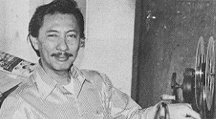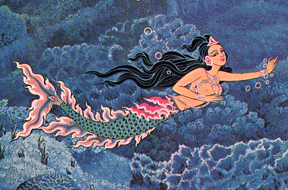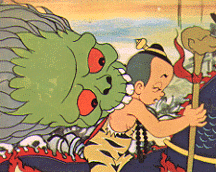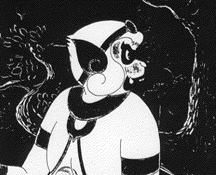Animation
World Magazine, Issue 2.1, April 1997
"A Screw Here, a Crank There":
Payut Ngaokrachang and the Origins of Thai Animation
by John A. Lent
 Payut Ngaokrachang.
Payut Ngaokrachang.
Thai animation owes part of its genesis to a "bug"
that laid Payut Ngaokrachang low in 1955.
The boredom that set in while Payut was sick spurred him to animate a cartoon
he had been drawing for the newspaper, Lakmuang. A gag cartoon,
it was based on a character who roamed Bangkok, taking in the sights. In
the particular gag Payut chose to animate in the film called Het Mahatsajal,
a policeman directs traffic, swaying to the tune of music in the manner
of Thai classical dancers. A woman begins to cross the street when the
zipper (a newly introduced fashion accoutrement in Thailand) on her dress
splits, diverting the policeman's attention with the result that cars pile
up all around him.
A series of fortuitous circumstances guided Payut's career because of this
animated skit. A news item stating that Payut did "Hollywood-like"
animation caught the attention of the US embassy, which asked to see the
"ten to twelve minute short." After that, the embassy gave him
$400, his name appeared in the press again (this time with the American
attaché), and before the year was out, the United States Information
Service hired him. He remained with the USIS for "32 years and 10
months and 18 days," painting and drawing, Payut said.

Sud Sakorn.
For training, the agency gave Payut a choice of
spending 6 to 8 months with Disney Studios or going to Japan. He chose
Japan, where he just "looked around, as animation did not exist there
at the time." Payut only made one animated film for the USIS, a 20-minute
recounting of the story of "Hanunan," the white monkey in the
classic Ramayana. The propaganda element was present in the form
of the red monkey, which represented communism. He also created a short
cartoon for SEATO (Southeast Asia Treaty Organization), based on the theme
that unity was necessary to combat communism.
In 1976, separate from his job, Payut began to animate the story of one
character, "Sud Sakorn," from a famous Thai literary work, Pra
Apai Manee, written by internationally-renowned author and poet, Sudthornpu.
The tale was a feast of incongruous adventures: Sud Sakorn, the son of
a mermaid and a musician, fights on different occasions, an elephant, shark,
and dragon horse, and encounters in his meanderings a king, a hermit, a
yogi, a magic wand, and ghosts.
Payut's feature, called Sud Sakorn, was 82 minutes long and took
two years to finish. It was the first Thai-produced, full-length animated
film. Production was plagued with shortages of capital, personnel, and
equipment. For the first 6 months, the crew was made up of 75 daytime and
25 nighttime workers, almost all students. By the second year, only 9 remained
as the "others could not work without money," Payut explained.
He did most of his own work at night since during the day, he was fully
employed at the USIS.
Payut is perhaps proudest of how he fashioned the equipment to make Sud
Sakorn. According to him, "I made a lot of my equipment from pieces
I got from junk of World War II military surplus. I'd find a screw here,
a crank there, etc. I used a combat camera and adapted it. I pulled together
pieces of wood, aluminum, whatever I could find." He delights in telling
about his first meeting with James Wang, president of Wang Productions,
the huge offshore animation house in Taiwan.
 Sud Sakorn.
Sud Sakorn.
After Wang had finished his studies at Indiana
University, he wanted to come see my studio. That was about 1980. He asked
me what system I used--Japanese or American? I said, `I don't understand.'
He persisted and I said again, `I don't understand.' Then I told him I
used the Payut system, the one I had devised. Wang always admired me for
this.
The intense and detailed work on this film seriously impaired Payut's eyesight
in that he became "cataract sick." As he put it, "I did
all the key drawings myself, even the layout and design. The students helped
with inbetweens. I was almost blind from doing that film and now I wear
contacts. My right eye is long, my left is short, crooked because of all
that detailed work."
In recent years, a considerable amount of Payut's time is spent in the
classroom. Working on the premise that unskilled personnel is the biggest
problem of animation, Payut, in a given week, is likely to have trained
animators at Thai Wang and drawing and illustration students at Rajamonkala
Institute, with an occasional seminar (on how to incorporate Thai literature
into cartoons, the week I met him) thrown in.
Three days a week he trains animators for James Wang, for whom he also
serves as advisor. Payut said he turned down two proposals to serve in
that capacity and accepted the third when Wang promised him space in which
to work. Already by 1993, Wang had set up 14 projects in Bangkok, 2 of
which Payut headed, and had provided 3 training sessions of 14, 7, and
14 students each. He had also brought in much equipment, including 10 cameras,
2 of which were for computer animation. The cartoons resulting from this
influx of resources are for foreign clients, mainly those from the United
States.
 Sud Sakorn.
Sud Sakorn.
But, it was Japanese, not American, animation
which Payut sees as a threat, claiming that Thai cartoonists slavishly
imitate the Japanese style. He also pointed out that Thai children favor
Japanese over American animation, adding:
The children don't pay attention to Disney; they follow Japanese cartooning
even though it is not smooth, in fact, it is very rough. They watch Japanese
animation every day and they are used to it--the rapid action. Disney seems
too slow for them. Even my granddaughter is this way. Disney spends lots
of money to be smooth, but children prefer rougher Japanese animation.
Of course, it is more violent too.
Payut made it clear he was not Thailand's first animator, that honor belonging
to a blockmaker, Saney Klykuan, who preceded him by a decade. In about
1945, the Thai government, campaigning to get ordinary citizens to wear
hats and farmers to wear boots, commissioned Saney to do a one-minute film
on the subject. Upon Saney's death a year later, Payut decided he wanted
to be an animator, but post-World War II was not an auspicious time for
such a career with the shortage of supplies such as celluloid.
At age 17, Payut took his first job, painting backgrounds for play sets
as he traveled up country with theater groups. "Sometimes, I'd be
put into action to sing a funny song," he recalled. About the same
time, 1946-47, he enrolled in classes to become an art teacher, followed
by a stint as a commissioner of block printing, where he made etchings,
and a longer stay in a company where he did advertising and other work.
It was while he was at that company that he contracted the "bug"
that changed his life and the destiny of Thai animation.

From Payut Ngaokrachang's 1957 short film,
The Adventure of Hanuman.
John A. Lent is Professor of Communication atTemple University, in Philadelphia. He is also the editor of Asian Cinema, the journal of the Asian Cinema Studies Society, which he also chairs, and managing editor of Witty World International Cartoon Magazine.
Back to the Table of Contents
Feedback?
Past Issues
![]()
![]()
![]()
![]()
![]()
![]()
[about | help
| home | info@awn.com
| mail | register]